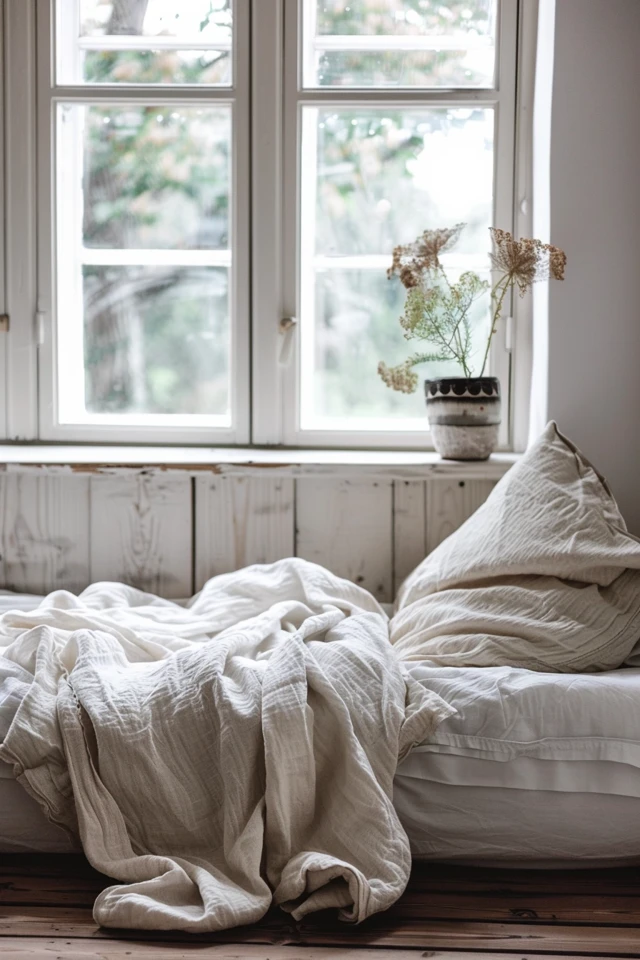Minimalist textiles are all about simplicity and a refined look. They bring a timeless elegance to any room. These textiles use gentle patterns and soothing colors to get that minimalist style. You can get inspired by places like Pinterest or Spoonflower for your home decor needs.
They make any space feel calm and elegant. They work well in both cozy living rooms and cool, minimal bedrooms. The right textiles can really lift your room’s elegance. With their simple designs, they turn your home into a peaceful escape.
Patterns are important in minimalist design. Adding subtle shapes or soft organic designs keeps things interesting but not too busy. Use these patterns in things like curtains, cushions, or upholstery. They can be focal points that add to the room’s overall style.
Minimalist colors are calming and muted. They help create a peaceful vibe. You’ll often see whites, beiges, grays, and pastels used. These soft colors make the clean lines and simple spaces stand out.
It’s key to choose textiles that match your existing colors and style. This way, everything looks unified and balanced. Using minimalist textiles the right way brings timeless elegance and peace to your space.
Places like Pinterest and Spoonflower offer tons of ideas for minimalist textiles. Let your imagination run free as you pick patterns and colors. Aim for that perfect combination of simplicity and class in your home.

Incorporating Texture in Minimalist Home Design
Texture is vital in minimalist home designs. It adds depth and interest. Natural materials and textiles make your space inviting. They match the simplicity of minimalist lines.
Wood, stone, and leather provide a timeless feel. Use them on floors, furniture, or as accents. This connects your space with nature and makes it cozy. A wooden coffee table or a stone wall can have a big impact.
Textiles like wool, linen, and cotton add coziness. They are great for throw blankets, cushions, and curtains. A chunky knit blanket on your sofa or a linen pillow can make your space more inviting.
Using texture well means finding a balance. Too much variety can feel cluttered. Too little can be cold. Pick a few textures carefully to bring your space to life.
“Texture should be used purposefully and thoughtfully to create a cohesive and serene environment,” says interior designer Jane Smith. “By incorporating natural materials and textiles, you can add a sense of richness to a minimalist space.”
Think about what you want your space to feel like. Do you prefer rustic or modern? Let the textures of your materials guide your choices. Focus on their unique beauty.

Creating a Harmonious Interior
Balance and harmony are essential in minimalism. Choose textures and colors that work well together. Use natural materials and textiles with shades that are alike. This ensures your space looks unified and appealing.
Keep it simple in minimalist design. Don’t use too many textures. Choose a few key items that match your home’s style and theme.
Adding Color to Minimalist Home Design
Minimalist interiors are usually filled with neutral colors. But adding some color can make your home feel lively. You can use just two or three main colors to keep a simple, yet vibrant look. White, black, and gray are good base colors to start with.
Textiles like pillows, throws, and rugs are a fun way to add color. They quickly boost the room’s energy. Pick items with patterns or textures that use your chosen colors. This will add depth and make the space interesting.
Don’t forget about accessories and artwork. They’re perfect for adding color to a minimalist room. You can use your color palette in items like vases, candles, or sculptures. These details will bring your space to life.
Use color thoughtfully to keep the minimalist look. Select colors that work well together. They should add to the beauty and balance of your home.
Balance is key when you want to add color to a minimalist space. You want it to make a statement but not overwhelm. Color should enhance the space, not overpower it.
Start by choosing a small color palette wisely. Then, add color with textiles, accessories, and art. This approach will help you create a colorful, yet peaceful home that shows off your style.

Conclusion
Texture and color are key for a cozy, balanced minimalist design. Natural materials like wood and stone make your home feel more inviting. Adding wool and linen textiles brings life to the space.
Focus on simple, complementary colors to achieve balance. Neutral shades as a base keep things calm, while adding bright colors with accessories brings vibrancy. This makes your home unique and lively.
Finding the right balance is the main goal. Mix textures and colors to create a welcoming space. Keep the lines clean and simple. This way, you make a harmonious, modern home that feels just right.

